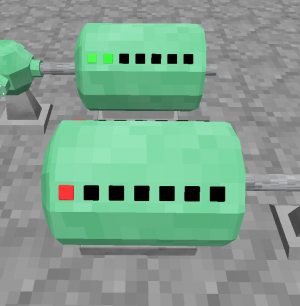Difference between revisions of "Generator"
From Electrical Age
Omega Haxors (talk | contribs) (Formatted Generator. Please help with polish.) |
(Correct the efficiency data.) |
||
| (3 intermediate revisions by 3 users not shown) | |||
| Line 2: | Line 2: | ||
|blockname=Generator | |blockname=Generator | ||
|requirements=[[Gas_turbine]], [[Steam_turbine]], or another Generator | |requirements=[[Gas_turbine]], [[Steam_turbine]], or another Generator | ||
| − | |image= | + | |image=Generator |
|poweredby=Shaft Power | |poweredby=Shaft Power | ||
|type=Single | |type=Single | ||
| Line 10: | Line 10: | ||
== Usage == | == Usage == | ||
The generator works almost exactly the same way as the heat turbine does, only it converts the motion from a rotating shaft into electricity rather than heat moving through a turbine. It also has the ability to convert back, to keep the voltage and rotation speed in check. If possible, avoid allowing electricity to pass back into the generator unless a spin-up is intended since dramatic losses will occur. | The generator works almost exactly the same way as the heat turbine does, only it converts the motion from a rotating shaft into electricity rather than heat moving through a turbine. It also has the ability to convert back, to keep the voltage and rotation speed in check. If possible, avoid allowing electricity to pass back into the generator unless a spin-up is intended since dramatic losses will occur. | ||
| + | |||
| + | ==lights== | ||
| + | |||
| + | The generator has lights along the side. | ||
| + | * Red: generator is drawing power | ||
| + | * Green: Generator is providing power. | ||
| + | |||
== Efficiency == | == Efficiency == | ||
| − | When converting electricity into shaft power, only | + | When converting electricity into shaft power, only 75% of the power actually goes into creating motion. The other way around, converting shaft power to electricity, is 95% efficient. |
| − | |||
| − | |||
Latest revision as of 19:00, 26 April 2020
Generator
| Block type: | Single |
| Powered by: | Shaft Power |
| Requirements for operation: | Gas_turbine, Steam_turbine, or another Generator |
| Stackable: | Yes (64) |
Usage
The generator works almost exactly the same way as the heat turbine does, only it converts the motion from a rotating shaft into electricity rather than heat moving through a turbine. It also has the ability to convert back, to keep the voltage and rotation speed in check. If possible, avoid allowing electricity to pass back into the generator unless a spin-up is intended since dramatic losses will occur.
lights
The generator has lights along the side.
- Red: generator is drawing power
- Green: Generator is providing power.
Efficiency
When converting electricity into shaft power, only 75% of the power actually goes into creating motion. The other way around, converting shaft power to electricity, is 95% efficient.
